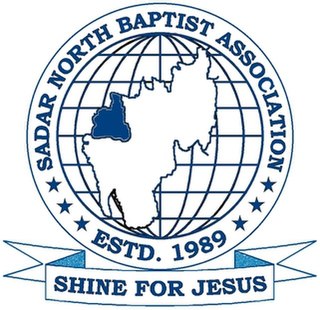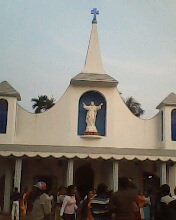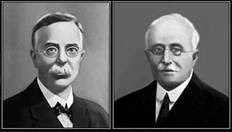
Dhalai is an administrative district in the state of Tripura in India. The district headquarter is in Ambassa. As of 2011 it was the least populous district of Tripura, although it is the largest district in the state.

The Tripura Baptist Christian Union (TBCU) is a Baptist Christian denomination in Tripura, India. It has its head office in Agartala, the state capital. The TBCU is affiliated to the Asia Pacific Baptist Federation (APBF) and the Baptist World Alliance (BWA). It is also a member church in the North East India Christian Council (NEICC), a regional church body of the National Council of Churches in India (NCCI).
Khumulwng is a town in the West Tripura district in the Indian state of Tripura. It is the headquarters and the largest town of the Tripura Tribal Areas Autonomous District Council.

Sadar North Baptist Association (SNBA) is a Baptist Christian denomination in Tripura. It is located within the West Tripura district of Tripura in India.
Mizoram Presbyterian ChurchSynod is the largest Christian denomination in Mizoram, northeast India. It was a direct progeny of the Calvinistic Methodist Church in Wales. It is one of the two churches founded by the missionaries and is now one of the constituent bodies of a larger denomination Presbyterian Church of India (PCI), which has its headquarters in Shillong, Meghalaya. The administrative body called the Mizoram Synod has its headquarters at Mission Veng, Aizawl. As the first church, it remains the largest denomination in Mizoram.
The Presbyterian Church of India (PCI) is a mainline Protestant church based in India, with over one and a half million adherents, mostly in Northeast India. It is one of the largest Christian denominations in that region.
The Diocese of Agartala is a Catholic diocese comprising the entire State of Tripura in the ecclesiastical province of Shillong in India. The cathedral is St. Francis Xavier Cathedral in Agartala.

Christianity is one of the religions in Tripura, a state in North East India. According to the Indian Census 2011, the population of Christians in Tripura is 159,882 or 4.35% of the total population. Christians are mostly found among the indigenous communities of the state such as the Tripuri, Lushai, Kuki, Darlong, Halam etc. Among the Scheduled Tribes of the state Christians share is 13.12% of the population.

James Herbert Lorrain, or Pu Buanga, was a Scottish Baptist missionary in northeast India, including Mizoram, Assam, and Arunachal Pradesh. He and Frederick William Savidge reduced the Lushai language to writing—devised an alphabet using Roman lettering and phonetic form of spelling based on Hunterian system translation; compiled grammar and dictionaries for missionary activities and clerical administration.
William Williams was a Welsh Presbyterian missionary to Khasi Hills, northeast India, in the late 19th century. He was a son of a ship captain in Nanternis, a small village in Wales. Following his father's footstep he became a sailor for five years. Then he took a profession in carpentry for two years. After graduating in theology from East London Missionary Training Institute he became a pastor. Pursuing his ambition he became a missionary of the Welsh Calvinistic Methodist Foreign Mission to Khasi people in India from 1887 until his death. He died of typhoid in 1892.

Synod Hospital, Durtlang is a general hospital and nursing school in Aizawl, Mizoram, India. The hospital is widely known among Mizo people as "Durtlang Hospital". It is managed and governed by the Mizoram Presbyterian Church Synod. The hospital was established in 1928 by the Calvinistic Methodist Church as a nursing institute. It is the second hospital established, and the largest non-governmental hospital in Mizoram. It has a registered capacity of 355 beds.

Christianity is the largest religion in Mizoram. The majority 87% of Mizoram population are Christian in various denominations, predominantly Presbyterian. More than 98% of the Mizos are Christians by faith. The Government of Mizoram declared that Christianity plays a very important role among the daily life of Mizo community and therefore further declared that Christianity as the religion of the state. The culture of Mizoram is mainly influenced by Christianity. Hence, Christianity was given a special status on the state by the government while maintaining a minimum level of secular environment and approach. In June 2018, the government of Mizoram including Vanlalruata, president of anti-corruption organisation-turned-political party, People's Representation for Identity and Status of Mizoram claim that Mizoram is a Christian state. Hindus form a small minority (3.55%) mainly of Manipuris and there are also around (7.93%) Buddhists according to the 2001 census, mostly made up from Chakma settlers of Arakan origin. There are about 8,000 mostly ethnic Mizo followers of a Judaic group Bnei Menashe, who claim descent from the biblical Menasseh. Muslims make up about 1.1% of the state population.
Zairema was a Presbyterian minister, and a pioneer in theology and literature among the Mizo people of northeast India. He was the first Mizo to obtain the degrees of BSc and BD. He died of cardiac problem on the morning of 17 December 2008 at his residence in Aizawl at the age of 91. He is best remembered as the "father of Mizoram Synod".
North East India Christian Council (NEICC) is a Protestant ecumenical council of North East India, affiliated to the National Council of Churches in India as one of the regional councils in the year 1939.

Frederick William Savidge was a pioneer English Christian missionary in northeast India. He and James Herbert Lorrain brought Protestantism to Mizoram, and some parts of Assam and Arunachal Pradesh. Together they were entirely responsible for the creation of written language in Mizo, beginning of literacy, origin of formal education and establishment of churches in Mizoram. They devised the original Mizo alphabets based on Roman script, prepared the first book and dictionary in Mizo, started the first school among the Mizos. Mizoram has become the most Christian populated state in India. As a professional educator Savidge was single-handedly responsible for introducing quality education in Mizoram. He is deservedly known as the Father of Mizo Education.
Edwin Rowlands was a Welsh Christian missionary in northeast India and Burma. He was a professional teacher, singer, composer, poet, translator and literary figure among the Mizo people. He was regarded as the most beloved of all British missionaries in Mizoram. He was more popularly known as Zosapthara. He made the major hymns in Mizo and Khumi which are still in use. He modified the original Mizo alphabet and his system became the standard in Mizo language. He created written language for Khumi people in Burma, and for Bhil people in Maharashtra. His literary works are the foundation of Mizo literature. He was the first administrator of education in Mizoram as Honorary Inspector of Schools. Despite objection from various corners he married Thangkungi, a Mizo girl.

The history of Christianity in Mizoram covers the origin and development of all forms of Christianity in Mizoram since the British occupation at the end of the 19th century until Indian Independance. Christianity arrived due to British intervention in tribal warfare, raids of British plantations. The ensuing punitive British military expedition was called the Lushai Expedition of 1871. The subsequent annexation of the erstwhile Lushai Hills to the British Empire opened the gateway for British Christian missions to evangelise the Mizo people.







